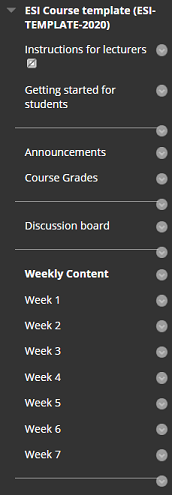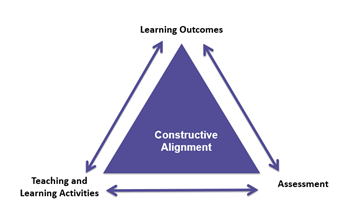Course - week - steps

Some key elements to start with redesigning your online course:
- Communicate the course learning outcomes clearly; this helps students to understand what is expected from them
- Self-assessment and motivating students becomes more relevant in online course
- S upport active learning and interaction between students
- Provide clear instructions for the learning activities
Online learning differs from face-to-face learning in that it requires more independence from students and a different guidance system by the lecturer. It needs a roadmap for learning, so that it is clear to students how they can move through the course and its learning activities (watching videos, reading articles, taking part in discussions, doing quizzes, exploring links, experimenting with tools, doing assignments, etc) in the right way.
Online courses are much more than lists of resources students are asked to wrestle through: they are carefully built up sequences of learning opportunities, built up around course material, activities, and conversation. It is essential to use a variety of activities and self-assessment to structure students learning and motivate them to learn on a distance at their own.
A good course roadmap, or outline, contains relevant content, but allows for some self-pacing, (self-)assessment, interaction and some diversity in the research questions or approaches they can explore. Structured like this, students can take more ownership of their learning: they know how they are going and if they are on track to reach the learning outcomes.
Another important element is allowing, but also provoking enough student-student and student-lecturer interaction. These are built into the course roadmap and can consist of BlackBoard Collaborate sessions, working together on projects via Google tools, using online polls and stimulating the use of the course’s online discussion board by explicitly asking for students to post questions or respond to a question that you raised for them to answer for themselves and share with the others.

Finally, make sure your roadmap contains regular moments for students to (self-)assess how they are doing. These can be done by adding a simple multiple choice quiz, invite students to share a one-paragraph take-away from your online lecture with a peer, or provide them with a rubric to self-assess a product that they have created. Make sure there are enough formative (not for a grade) assessment opportunities before moving on to summative tests that are graded.
Make sure that all forms of assessment are aligned with your learning outcomes and the learning activities and if they are not, you may need to rethink one of the elements.

How to create a great online learning week?
Each week takes students through a number of course steps, which are the building blocks of your course (see below). Weeks usually revolve around certain subtopics within the course or help to build an essential skill. Their relevance to the course’ learning outcomes should be totally clear, and you might even consider formulating outcomes per week. By completing a week, or cycle of learning, students will have made substantial progress in reaching the course goals. Our recommended course structure:
-
Learning outcomes per week (derived from course Learning Outcomes)
-
Make clear when and how you are available for questions
-
Use a variety of different online learning and teaching activities
-
Finish each week with some sort of self-assessment
Always think carefully about the material you’re assigning in a step and use only core material: that which is necessary for students to learn. Lengthy texts, such as whole book chapters, can be overwhelming, and are often better divided up in smaller steps. If material is not essential to completing the step, move it to “related links and resources.”

How to create progressive course steps?
The smallest unit of learning within an online course is a course step. These are the course’s building blocks. Each step should combine materials with conversation and, as such, form a coherent and complete learning experience (examples of steps in the first course week).
This means that a step is much more than a resource, such as an online article, that has been uploaded to Nestor.Students should know why a step is relevant to them in achieving the learning outcomes of the course, and feel a sense of accomplishment when they have completed each step or group of steps. The latter will help them to get motivated to keep learning.
It is important to clearly communicate to students what the sequence is, e.g. when to read, watch, or do something. Make sure these resources and activities are posted directly underneath each other in your Nestor course. All of them together form a step. Try to make steps as small as possible. So not: “Read these three articles”, but rather “1. Read article 1”, “2. Have a discussion about the article in the discussion forum”, “3. Read article 2”, “4. A small quiz about article 2” etc..
Most lecturers will tend to start to add content (with links to articles, book chapters, audio, video, lectures, etc) first, but to make sure you stimulate active learning it is wise to accompany texts with reading questions, to guide students in getting the important elements out of the content. Content can then be followed by other prompts that stimulate conversation, or tasks where students apply the obtained knowledge, and additional resources or assessment.
In addition to relevant content, steps can contain the following:
- Interaction Steps combine content with explanation and discussion. You can host meetings, post questions about a reading, ask students to post questions or write a response, or in another way accompany texts with a structure for interaction.
- Tasks Each step in the course should ask students to do something. These tasks should allow them to practice skills, deepen knowledge, or apply material so that they get one step closer to achieving course goals. Such tasks should enable student progress, helping them move along. Think of answering questions, developing arguments, creating small projects, doing observations.
- Related links and resources Allow students to refresh their knowledge or delve deeper into a subject by adding a list of optional resources. Make sure these are clearly marked as optional, so as not to punish students who do not wish to engage with them. Communicate clearly what these extra resources do by labelling them “background information,” “extension,” etc.
-
Formative feedback and completion
Each step ends with a moment of reflection and feedback. Before moving on to the next step, you want your students to know they’ve successfully completed the current one. You can design a quick quiz or other form of formative assessment. Ideally, you can give feedback to students on their performance. Keep these moments low-key, and low-stakes, but give students a sense of achievement each time they’ve completed a step (some courses use “badges” for this).
Always think carefully about the material you’re assigning in a step and use only core material: that which is necessary for students to learn. Lengthy texts, such as whole book chapters, can be overwhelming, and are often better divided up in smaller steps. If material is not essential to completing the step, move it to “related links and resources.”
On this page you can find more information about tools which might help you to create steps.
| Last modified: | 01 May 2020 12.01 p.m. |
